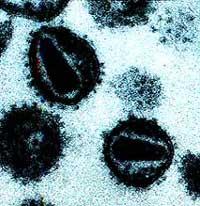Polio vaccines are innocent in the case of AIDS
2001/04/26 Galarraga Aiestaran, Ana - Elhuyar Zientzia

This theory first appeared in 1987. According to the article published by Tom Curtis in 1992, HIV was passed on to humans by a virus (SIV AGM) that causes the immunodeficiency of African green monkeys. Since 1963 the polio vaccine was replaced by Asian macaque cells by those of African green monkeys. After 25 years, many African green monkeys had the SIVAGM virus, so they studied vaccines for this virus and some called for the use of human cells in vaccine preparation.
This theory gained more strength in society in 1999 due to the impact it had on its explanations in the book published by journalist Edward Hooper. According to him, researchers at the Wistar Institute in Philadelphia, unconsciously, when preparing the polio vaccine, infected it with a virus that produces immunodeficiency in chimpanzees. The vaccine was tested in Congo and received by more than a million people between 1957 and 59. In this way, HIV-1 was expanded among humans, the type of virus that generates the most AIDS cases.

Four groups of unrelated researchers have studied the vaccine tested in Congo and found no trace of chimpanzee tissue, the variant of the virus affecting HIV or primates, and the SIV AGM of green monkeys, which would be their predecessor. They have even proven that the way it affects humans (HIV) appeared before testing the vaccine in Congo.
For example, one of these groups of researchers has found remains of macaque tissues in the vaccine samples of the time. In fact, the Wistar Institute denied the use of chimpanzees saying it did them with macaque cells. Now it is proven. In addition, these samples were in the freezer and Hooper did not have them at his disposal when he exposed his theory, as they did not take them out until the elimination studies were conducted.
Finally, from studies of HIV samples collected in Congo in 1997, researchers at the University of Oxford concluded that many HIV subtypes could not come from the percentage of chimpanzee in the 1950s. According to this group, the common ancestor of known variants in Congo was in a human hostel and not in a primate, as Hooper promulgated.
The genetic history of the different types of GIB-1 follows a classic exponential epidemiological diffusion and shows no signs of contamination of the polar vaccine. According to researchers at the University of Oxford, the adaptation of the virus to man has been the result of an ecological process.

Gai honi buruzko eduki gehiago
Elhuyarrek garatutako teknologia





